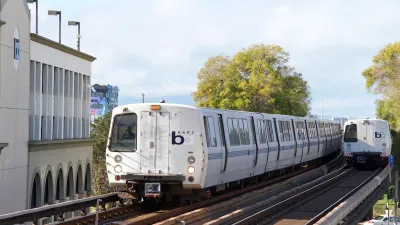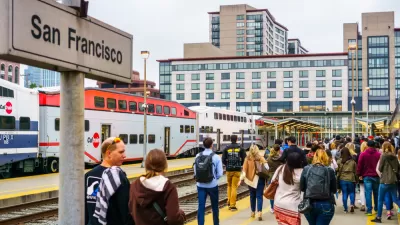BART passengers could someday see a second route across the San Francisco Bay, with a parallel but totally new alignment and crossing points on the either side of the bay.

"BART officials are starting to study a second Transbay Tube," reports Michael Cabanatuan. That news follows "years of supposition and pie-in-the-sky conjecture from planners and passengers alike," according to Cabanatuan, but now the real planning can finally begin.
"Much of the talk about a new rail tunnel has centered on its location, or alignment, including where the BART lines would head once they emerge from the tube, and how they could connect with jobs and housing," according to Cabanatuan. The project could eventually cost $12 billion to $15 billion, and the possibilities for crossings and alignment are still wildly speculative, but lots of fun for fans of BART and The Bay Area, or public transit and metropolitan areas more generally.
As for the expected cost just to study the idea, "BART plans to pay for a variety of studies and some early engineering with some of the $200 million set aside in Measure RR, its $3.5 billion system modernization bond. Regional Measure 3, the Bay Area toll increase proposal on the June ballot, would set aside $50 million to further study the new tube, and Caltrans and the state Transportation Agency have said study money should be available as well, reports Cabanatuan.
Oddly enough, there's been renewed talk of a second Bay Bridge span in recent weeks—mostly speculative talk originating from the office of U.S. Senator Diane Feinstein that stands in obvious juxtaposition of the BART plan.
The source article includes a lot more detail about the various regional organizations and powers that will partner on the planning process and could eventually sway the final alignment of the second Transbay Tube.
FULL STORY: BART gets serious about a 2nd East Bay-S.F. Transbay Tube

Alabama: Trump Terminates Settlements for Black Communities Harmed By Raw Sewage
Trump deemed the landmark civil rights agreement “illegal DEI and environmental justice policy.”

Planetizen Federal Action Tracker
A weekly monitor of how Trump’s orders and actions are impacting planners and planning in America.

How Atlanta Built 7,000 Housing Units in 3 Years
The city’s comprehensive, neighborhood-focused housing strategy focuses on identifying properties and land that can be repurposed for housing and encouraging development in underserved neighborhoods.

In Both Crashes and Crime, Public Transportation is Far Safer than Driving
Contrary to popular assumptions, public transportation has far lower crash and crime rates than automobile travel. For safer communities, improve and encourage transit travel.

Report: Zoning Reforms Should Complement Nashville’s Ambitious Transit Plan
Without reform, restrictive zoning codes will limit the impact of the city’s planned transit expansion and could exclude some of the residents who depend on transit the most.

Judge Orders Release of Frozen IRA, IIJA Funding
The decision is a victory for environmental groups who charged that freezing funds for critical infrastructure and disaster response programs caused “real and irreparable harm” to communities.
Urban Design for Planners 1: Software Tools
This six-course series explores essential urban design concepts using open source software and equips planners with the tools they need to participate fully in the urban design process.
Planning for Universal Design
Learn the tools for implementing Universal Design in planning regulations.
Jessamine County Fiscal Court
Caltrans
Institute for Housing and Urban Development Studies (IHS)
City of Grandview
Harvard GSD Executive Education
Toledo-Lucas County Plan Commissions
Salt Lake City
NYU Wagner Graduate School of Public Service





























